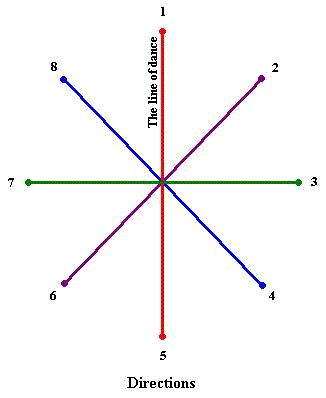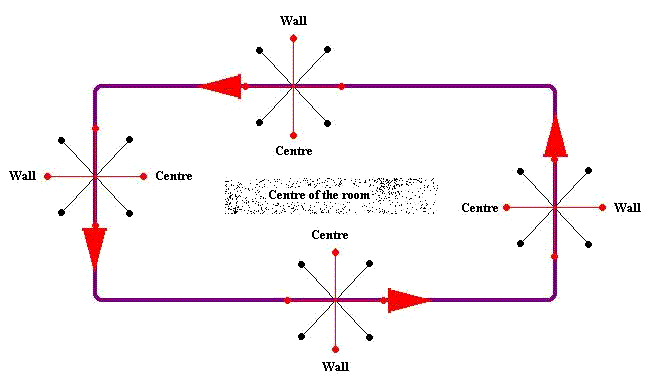
Email : [email protected] Or General Mailer
 |
Jai Chavan's
"Dance-Sport" Email : [email protected] Or General Mailer |
| Back || Master Pg. || Overview || Contents || Alphabetical Index || Home || Next |
Direction
 |
The direction of the march or the war dance (as in the dance parlance) on a parade ground normally all over the world is always counter clockwise. |
Importance
The dance sport is simple. Knowing a few basic figures
is good enough for social dancing, so long as it's done well and
with confidence. And confidence can come with honing the little
that one knows, which means continuous practice of the same thing
on and on, and yet to keep one's self alert for something new in
it. As good as rediscovery of one's self continuously.
However we need a change as fast as possible. This is where the
directions come in handy. Dancing the same set of step at
different angles makes it look and feel different. So whatever
little one knows, the illusion can be created to show and feel
for one's self, of the vast repertoire of "step" that
one has mastered.
Exercise 1
Line of dance or the LOD
Imagine a starting point and an end point separated by about 10
feet. Now when you join the two points with an imaginary straight
line, it becomes the LOD or the line of dance. From the starting
point one may dance straight to the end point or may curve from
the left or right, or may move in a zigzag manner. Whatever the
case, the imaginary straight line remains the LOD, and its
direction if from the start point to the end point.
1. Facing LOD
Standing on the centre of the imaginary line, both the feet
together and pointing straight ahead towards the end point and
shoulders remain square to the LOD. (The imaginary line joining
the two shoulders is perpendicular to the LOD, this means that
the shoulders are square to the LOD). This position is 'Facing
the LOD'; consequently one is backing against the LOD.
When in this position, in any part of the dance hall, the wall is
always to the right and the centre always towards the left, with
respect to the dancer/in relation to the dancer.
2. Now transfer full body weight on to the left foot, and turn
the right foot with both the heels touching, at 45 degrees. Next
transfer the weight on to the right foot and bring the left foot
to the right foot, such that both the feet point in the same
direction. The shoulders remain square to this direction. This
position is called facing "diagonal to the Wall".
Consequently it is also backing "diagonal to the centre
against the LOD."
3. Now turn further to the right, similar to above. This position
is facing the "wall", and consequently backing the
"centre".
4. Turn further to the right. This position is facing
"diagonal to the wall against the LOD", and
consequently backing "diagonal to the centre".
5. Turn further to the right and you would be backing the LOD, or
facing against the LOD.
6. Next turn to the right at 45 degrees. This position is facing
"diagonal to the centre against the LOD", and
consequently backing "diagonal to the wall".
7. Next turn will lead to the position when one is facing the
"centre", and backing the "wall".
8. Further turn will lead to the position, facing "diagonal
to the centre" and backing "diagonal to the wall
against the LOD".
Note
that all the directions given are with respect to the
dancer, and not the dance place. If one is dancing in the open
and facing the LOD, then the "wall" is still to the
right of the person.
In brief
 |
1 - facing the LOD & backing against the LOD 2 - facing diagonal to the wall & backing diagonal to the centre against the LOD 3 - facing the wall & backing the centre 4 - facing diagonal to the wall against the LOD & backing diagonal to the centre 5 - facing against the LOD & backing the LOD 6 - facing diagonal to the centre against the LOD & backing diagonal to the wall 7 - facing the centre & backing the wall 8 - facing diagonal to the centre & backing diagonal to the wall against the LOD. |
Flow of the Dance

The direction of flow of a dance is always counter clockwise.
This part is taken from the "marching" or the "war
dance" as done by the soldiers. The "marching"
always proceeds counter clockwise through the world. The reason
is that most people are right handed and the "salute"
is with the right hand. And the seniors witnessing the parade are
stationed on the periphery of the ground. This necessitates the
march to move counter clockwise. This same principle got adapted
into the dance as well, for the smooth and easy flow.
See the picture given for the flow of the dance and the direction
with respect to the dancer at various stages.
| Back || Master Pg. || Overview || Contents || Alphabetical Index || Home || Next |